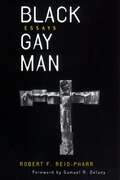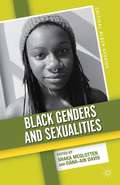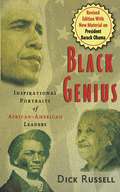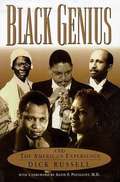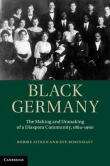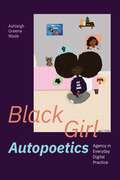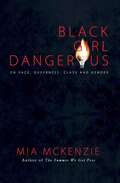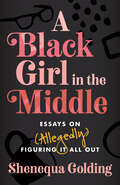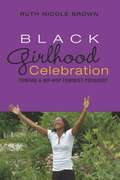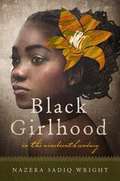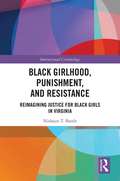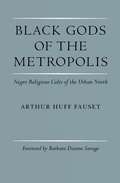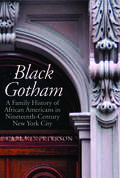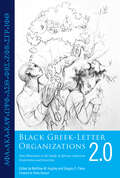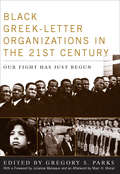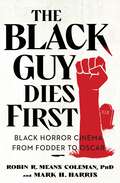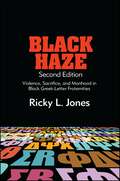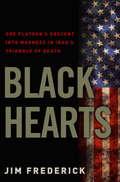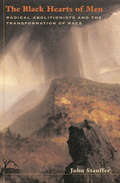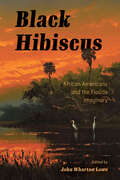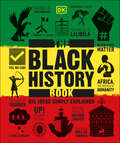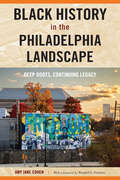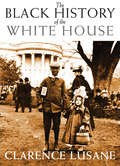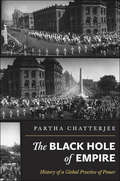- Table View
- List View
Black Gay Man: Essays (Sexual Cultures #6)
by Robert F. Reid-PharrThe landmark book that established Robert Reid-Pharr as one of America's most exciting and challenging left intellectualsAt turns autobiographical, political, literary, erotic, and humorous, Black Gay Man spoils our preconceived notions of not only what it means to be black, gay and male but also what it means to be a contemporary intellectual. Both a celebration of black gay male identity as well as a powerful critique of the structures that allow for the production of that identity, Black Gay Man introduced the eloquent voice of Robert Reid-Pharr in cultural criticism. At once erudite and readable, the range of topics and positions taken up in Black Gay Man reflect the complexity of American life itself. Treating subjects as diverse as the Million Man March, interracial sex, anti-Semitism, turn of the century American intellectualism as well as literary and cultural figures ranging from Essex Hemphill and Audre Lorde to W.E.B. DuBois, Frantz Fanon and James Baldwin, Black Gay Man is a bold and nuanced attempt to question prevailing ideas about community, desire, politics and culture. Moving beyond critique, Reid-Pharr also pronounces upon the promises of a new America.
Black Genders and Sexualities
by Dána-Ain Davis Shaka McglottenCutting across the humanities and social sciences, and situated in sites across the black diaspora, the work in this book collectively challenges notions that we are living in a post-racial age and instead argue for the specificity of black cultural experiences as shaped by gender and sex.
Black Genius: Inspirational Portraits of African-American Leaders
by Dick RussellIntimate, in-depth portraits, interviews, and essays of America's black leaders-from the founding of the nation and Frederick Douglass to the 2008 presidential race and Barack Obama. Each figure is interconnected with the next, exploring themes of family and intergenerational community, spirituality, and diligence, activism, and struggle. These remarkable portraits reveal the true spirit of the American pioneers who forged much of the heart of this nation, but whose achievements have been largely overlooked. New York Times bestselling author Dick Russell examines the lives of musicians, civil rights leaders, philosophers, writers, and actors including Duke Ellington, Will Marion Cook, Louis Armstrong, Wynton Marsalis, Albert Murray, Ralph Ellison, Toni Morrison, and Romare Bearden. Concluding with a list of sources and suggested reading, this fascinating and vibrant look at American history is a must for any collection.
Black Genius and the American Experience
by Dick RussellThe findings from wide-ranging interviews and careful historical research, Black Genius explores the roots of black achievement in America. The results are surprising and inspiring. Interweaving past and present, beginning with this country's inception, Russell covers the importance of continuity and tradition in nurturing black artists, scientists, and leaders. Here are memorable portraits of Wynton Marsalis, Ralph Ellison, Louis Armstrong, Toni Morrison, Duke Ellington, James Baldwin, Paul Robeson, Muhammad Ali, Lois Mailou-Jones, and other black notables. Through their eyes, we see how they were inspired, fostered, and encouraged by their mentors, how the creative tradition was passed from one generation to the next. This great theme of interconnectedness is played out, for example, in Wynton Marsalis's links to not only Ellington and Armstrong, but also, through the venerable author Albert Murray, to Ellison and the artist Romare Bearden. In addition to these well-known figures, Russell also rediscovers less familiar ones: writers, activists, scientists, and artists whose reputations may be underrecognized.
Black Germany
by Robbie Aitken Eve RosenhaftThis groundbreaking history traces the development of Germany's black community, from its origins in colonial Africa to its decimation by the Nazis during World War II. Robbie Aitken and Eve Rosenhaft follow the careers of Africans arriving from the colonies, examining why and where they settled, their working lives and their political activities, and giving unprecedented attention to gender, sexuality and the challenges of 'mixed marriage'. Addressing the networks through which individuals constituted community, Aitken and Rosenhaft explore the ways in which these relationships spread beyond ties of kinship and birthplace to constitute communities as 'black'. The study also follows a number of its protagonists to France and back to Africa, providing new insights into the roots of Francophone black consciousness and postcolonial memory. Including an in-depth account of the impact of Nazism and its aftermath, this book offers a fresh critical perspective on narratives of 'race' in German history.
Black Girl Autopoetics: Agency in Everyday Digital Practice
by Ashleigh Greene WadeIn Black Girl Autopoetics Ashleigh Greene Wade explores how Black girls create representations of themselves in digital culture with the speed and flexibility enabled by smartphones. She analyzes the double bind Black girls face when creating content online: on one hand, their online activity makes them hypervisible, putting them at risk for cyberbullying, harassment, and other forms of violence; on the other hand, Black girls are rarely given credit for their digital inventiveness, rendering them invisible. Wade maps Black girls’ everyday digital practices, showing what their digital content reveals about their everyday experiences and how their digital production contributes to a broader archive of Black life. She coins the term Black girl autopoetics to describe how Black girls’ self-making creatively reinvents cultural products, spaces, and discourse in digital space. Using ethnographic research into the digital cultural production of adolescent Black girls throughout the United States, Wade draws a complex picture of how Black girls navigate contemporary reality, urging us to listen to Black girls’ experience and learn from their techniques of survival.
Black Girl Dangerous: On Race, Queerness, Class And Gender
by Mia McKenzieMia McKenzie, creator of the enormously popular website Black Girl Dangerous, writes about race, queerness, class and gender in a concise, compelling voice filled at different times with humor, grief, rage, and joy. In this collection of her work from BGD (now available only in this book), McKenzie's nuanced analysis of intersecting systems of oppression goes deep to reveal the complicated truths of a multiply-marginalized experience. McKenzie tackles the hardest questions of our time with clarity and courage, in language that is accessible to non-academics and academics alike. She is both fearless and vulnerable, demanding and accountable. Hers is a voice like no other. "One of the most provocative and insightful writers of our generation." -Aura Bogado, Colorlines "A fierce voice among a generation of queer and trans folk of color." -Janet Mock, New York Times Bestselling Author of "Redefining Realness" "Tough-love activism at its best-straightforward, challenging, whip-smart, and uncompromising." -Andi Zeisler, Bitch Magazine
Black Girl Dangerous: On Race, Queerness, Class and Gender
by Mia McKenzieMia McKenzie, creator of the enormously popular website Black Girl Dangerous, writes about race, queerness, class and gender in a concise, compelling voice filled at different times with humor, grief, rage, and joy. In this collection of her work from BGD (now available only in this book), McKenzie's nuanced analysis of intersecting systems of oppression goes deep to reveal the complicated truths of a multiply-marginalized experience. <p><p>McKenzie tackles the hardest questions of our time with clarity and courage, in language that is accessible to non-academics and academics alike. She is both fearless and vulnerable, demanding and accountable. Hers is a voice like no other.
A Black Girl in the Middle: Essays on (Allegedly) Figuring It All Out
by Shenequa GoldingA blazingly honest essay collection from a refreshing new voice exploring the in-between moments for Black women and girls, and what it means to simply exist&“At thirty-seven years old I can say Shenequa is a big name and I&’m a big, bold woman.&”Shenequa Golding doesn&’t aim to speak for all Black women. We&’re too vast, too vibrant, and too complicated. As an adult, Golding begins to own her boldness, but growing up, she found herself &“kind of in the middle,&” fluctuating between not being the fly kid or the overachiever. Her debut collection of essays, A Black Girl in the Middle taps into life&’s wins and losses, representing the middle ground for Black girls and women.Golding packs humor, curiosity, honesty, anger, and ultimately acceptance in 12 essays spanning her life in Queens, NY, as a first generation Jamaican American. She breaks down the 10 levels of Black Girl Math, from the hard glare to responses reserved for unfaithful boyfriends. She comes to terms with and heals from fraught relationships with her father, friends, and romantic partners. She takes the devastating news that she&’s a Black girl with a &“flat ass&” in stride, and adds squats to her routine, eventually. From a harrowing encounter in a hotel room leading her to explore celibacy (for now) to embracing rather than fearing the &“Milli Vanilli&” of emotions in hurt and anger, Golding embraces everything she&’s learned with wit, heart, and humility. A Black Girl in the Middle is both an acknowledgment of the complexity and pride of not always fitting in and validation of what Black girlhood and womanhood can be.
Black Girlhood Celebration: Toward A Hip-Hop Feminist Pedagogy
by Ruth Nicole BrownThe celebration of Black girlhood is essential their principles and practices were the centred program. It examines how performances of everyday Black girlhood are mediated by popular culture, personal truths, and lived experiences, and how the discussion and critique of these factors can be a great asset in the celebration of Black girls.
Black Girlhood in the Nineteenth Century
by Nazera Sadiq WrightLong portrayed as a masculine endeavor, the African American struggle for progress often found expression through an unlikely literary figure: the black girl. Nazera Sadiq Wright uses heavy archival research on a wide range of texts about African American girls to explore this understudied phenomenon. As Wright shows, the figure of the black girl in African American literature provided a powerful avenue for exploring issues like domesticity, femininity, and proper conduct. The characters' actions, however fictional, became a rubric for African American citizenship and racial progress. At the same time, their seeming dependence and insignificance allegorized the unjust treatment of African Americans. Wright reveals fascinating girls who, possessed of a premature knowing and wisdom beyond their years, projected a courage and resiliency that made them exemplary representations of the project of racial advance and citizenship.
Black Girlhood, Punishment, and Resistance: Reimagining Justice for Black Girls in Virginia (Intersectional Criminology)
by Nishaun T. BattleBlack Girlhood, Punishment, and Resistance: Reimagining Justice for Black Girls in Virginia provides a historical comprehensive examination of racialized, classed, and gendered punishment of Black girls in Virginia during the early twentieth century. It looks at the ways in which the court system punished Black girls based upon societal accepted norms of punishment, hinged on a notion that they were to be viewed and treated as adults within the criminal legal system. Further, the book explores the role of Black Club women and girls as agents of resistance against injustice by shaping a social justice framework and praxis for Black girls and by examining the establishment of the Virginia Industrial School for Colored Girls. This school was established by the Virginia State Federation of Colored Women’s Clubs and its first President, Janie Porter Barrett. This book advances contemporary criminological understanding of punishment by locating the historical origins of an environment normalizing unequal justice. It draws from a specific focus on Janie Porter Barrett and the Virginia Industrial School for Colored Girls; a groundbreaking court case of the first female to be executed in Virginia; historical newspapers; and Black Women’s Club archives to highlight the complexities of Black girls’ experiences within the criminal justice system and spaces created to promote social justice for these girls. The historical approach unearths the justice system’s role in crafting the pervasive devaluation of Black girlhood through racialized, gendered, and economic-based punishment. Second, it offers insight into the ways in which, historically, Black women have contributed to what the book conceptualizes as “resistance criminology,” offering policy implications for transformative social and legal justice for Black girls and girls of color impacted by violence and punishment. Finally, it offers a lens to explore Black girl resistance strategies, through the lens of the Black Girlhood Justice framework. Black Girlhood, Punishment, and Resistance uses a historical intersectionality framework to provide a comprehensive overview of cultural, socioeconomic, and legal infrastructures as they relate to the punishment of Black girls. The research illustrates how the presumption of guilt of Black people shaped the ways that punishment and the creation of deviant Black female identities were legally sanctioned. It is essential reading for academics and students researching and studying crime, criminal justice, theoretical criminology, women’s studies, Black girlhood studies, history, gender, race, and socioeconomic class. It is also intended for social justice organizations, community leaders, and activists engaged in promoting social and legal justice for the youth.
Black Gods of the Metropolis
by Barbara Dianne Savage John Szwed Arthur Huff FausetStemming from his anthropological field work among black religious groups in Philadelphia in the early 1940s, Arthur Huff Fauset believed it was possible to determine the likely direction that mainstream black religious leadership would take in the future, a direction that later indeed manifested itself in the civil rights movement. The American black church, according to Fauset and other contemporary researchers, provided the one place where blacks could experiment without hindrance in activities such as business, politics, social reform, and social expression. With detailed primary accounts of these early spiritual movements and their beliefs and practices, Black Gods of the Metropolis reveals the fascinating origins of such significant modern African American religious groups as the Nation of Islam as well as the role of lesser known and even forgotten churches in the history of the black community.In her new foreword, historian Barbara Dianne Savage discusses the relationship between black intellectuals and black religion, in particular the relationship between black social scientists and black religious practices during Fauset's time. She then explores the complexities of that relationship and its impact on the intellectual and political history of African American religion in general.
Black Gotham
by Carla L. PetersonPart detective tale, part social and cultural narrative,Black Gothamis Carla Peterson's riveting account of her quest to reconstruct the lives of her nineteenth-century ancestors. As she shares their stories and those of their friends, neighbors, and business associates, she illuminates the greater history of African-American elites in New York City. Black Gothamchallenges many of the accepted "truths" about African-American history, including the assumption that the phrase "nineteenth-century black Americans" means enslaved people, that "New York state before the Civil War" refers to a place of freedom, and that a black elite did not exist until the twentieth century. Beginning her story in the 1820s, Peterson focuses on the pupils of the Mulberry Street School, the graduates of which went on to become eminent African-American leaders. She traces their political activities as well as their many achievements in trade, business, and the professions against the backdrop of the expansion of scientific racism, the trauma of the Civil War draft riots, and the rise of Jim Crow. Told in a vivid, fast-paced style,Black Gothamis an important account of the rarely acknowledged achievements of nineteenth-century African Americans and brings to the forefront a vital yet forgotten part of American history and culture.
Black Greek-Letter Organizations 2.0: New Directions in the Study of African American Fraternities and Sororities
by Matthew W. Hughey Gregory S. ParksAt the turn of the twentieth century, black fraternities and sororities, also known as Black Greek-Letter Organizations (BGLOs), were an integral part of what W.E.B. Du Bois called the “talented tenth.” This was the top ten percent of the black community that would serve as a cadre of educated, upper-class, motivated individuals who acquired the professional credentials, skills, and capital to assist the race to attain socioeconomic parity. Today, however, BGLOs struggle to find their place and direction in a world drastically different from the one that witnessed their genesis. In recent years, there has been a growing body of scholarship on BGLOs. This collection of essays seeks to push those who think about BGLOs to engage in more critically and empirically based analysis. This book also seeks to move BGLO members and those who work with them beyond conclusions based on hunches, conventional wisdom, intuition, and personal experience. In addition to a rich range of scholars, this volume includes a kind of call and response feature between scholars and prominent members of the BGLO community.
Black Greek-Letter Organizations in the 21st Century: Our Fight Has Just Begun
by Marc H. Morial“A masterpiece of multidisciplinary scholarship that clearly demonstrates the contemporary relevance of black fraternities and sororities.” —Hasan Kwame Jeffries, author of Bloody LowndesDuring the twentieth century, black Greek-Letter organizations (BGLOs) united college students dedicated to excellence, fostered kinship, and uplifted African Americans. Members of these organizations include remarkable and influential individuals such as Martin Luther King Jr., Congresswoman Barbara Jordan, novelist Toni Morrison, and Wall Street pioneer Reginald F. Lewis. Despite the profound influence of these groups, many now question the continuing relevance of BGLOs, arguing that their golden age has passed.To foster a greater engagement with the history and contributions of BGLOs, Black Greek-Letter Organizations in the Twenty-first Century brings together an impressive group of authors to explore the contributions and continuing possibilities of BGLOs and their members. Editor Gregory S. Parks and the contributing authors provide historical context for the development of BGLOs, exploring their service activities as well as their relationships with other prominent African American institutions. Both internally and externally, BGLOs struggle to forge a relevant identity for the new century. Internally, these groups wrestle with many issues, including hazing, homophobia, petty intergroup competition, and the difficulty of bridging the divide between college and alumni members. Externally, BGLOs face the challenge of rededicating themselves to their communities and leading an aggressive campaign against modern forms of racism, sexism, and other types of fear-driven behavior.By embracing the history of these organizations and exploring their continuing viability and relevance, Black Greek-Letter Organizations in the Twenty-first Century demonstrates that BGLOs can create a positive and enduring future and that their most important work lies ahead.
The Black Guy Dies First: Black Horror Cinema from Fodder to Oscar
by Robin R. Means Coleman Mark H. HarrisA definitive and surprising exploration of the history of Black horror films, after the rising success of Get Out, Candyman, and Lovecraft Country from creators behind the acclaimed documentary, Horror Noire.The Black Guy Dies First explores the Black journey in modern horror cinema, from the fodder epitomized by Spider Baby to the Oscar-winning cinematic heights of Get Out and beyond. This eye-opening book delves into the themes, tropes, and traits that have come to characterize Black roles in horror since 1968, a year in which race made national headlines in iconic moments from the enactment of the 1968 Civil Rights Act and Martin Luther King Jr.&’s assassination in April. This timely book is a must-read for cinema and horror fans alike.
Black Haze, Second Edition: Violence, Sacrifice, and Manhood in Black Greek-Letter Fraternities (SUNY series in African American Studies)
by Ricky L. JonesAre black men naturally violent? Do they define manhood in the same way as their counterparts across lines of race? Are black Greek-letter fraternities among the most dangerous student organizations on American college and university campuses? Can their often-dangerous initiation processes be stopped or even modified and, if not, what should be done about them? In this second edition of Black Haze, Ricky L. Jones takes on these questions and more. The first edition was an enlightening and sometimes disturbing examination of American men's quest for acceptance, comfort, reaffirmation, and manhood in a world where their footing is often unstable. In this new edition Jones not only provides masterful philosophical and ethical analyses but he also forces the engagement of a terrifying real world process that damages and kills students with all too frequent regularity. With a revealing new preface and stunning afterword, Jones immerses the reader in an intriguing and dark world marked by hypermasculinity, unapologetic brutality, and sometimes death. He offers a compelling book that ranges well beyond the subject of hazing—one that yields perplexing questions and demands difficult choices as we move forward in addressing issues surrounding fraternities, violent hazing, black men, and American society.
Black Hearts: One Platoon's Descent into Madness in Iraq's Triangle of Death
by Jim FrederickThis is the story of a small group of soldiers from the 101st Airborne Division's fabled 502nd Infantry Regiment--a unit known as "the Black Heart Brigade." Deployed in late 2005 to Iraq's so-called Triangle of Death, a veritable meat grinder just south of Baghdad, the Black Hearts found themselves in arguably the country's most dangerous location at its most dangerous time. Hit by near-daily mortars, gunfire, and roadside bomb attacks, suffering from a particularly heavy death toll, and enduring a chronic breakdown in leadership, members of one Black Heart platoon--1st Platoon, Bravo Company, 1st Battalion--descended, over their year-long tour of duty, into a tailspin of poor discipline, substance abuse, and brutality.Four 1st Platoon soldiers would perpetrate one of the most heinous war crimes U.S. forces have committed during the Iraq War--the rape of a fourteen-year-old Iraqi girl and the cold-blooded execution of her and her family. Three other 1st Platoon soldiers would be overrun at a remote outpost--one killed immediately and two taken from the scene, their mutilated corpses found days later booby-trapped with explosives.Black Hearts is an unflinching account of the epic, tragic deployment of 1st Platoon. Drawing on hundreds of hours of in-depth interviews with Black Heart soldiers and first-hand reporting from the Triangle of Death, Black Hearts is a timeless story about men in combat and the fragility of character in the savage crucible of warfare. But it is also a timely warning of new dangers emerging in the way American soldiers are led on the battlefields of the twenty-first century.From the Hardcover edition.
The Black Hearts of Men: Radical Abolitionists and the Transformation of Race
by John StaufferAt a time when slavery was spreading and the country was steeped in racism, two white men and two black men overcame social barriers and mistrust to form a unique alliance that sought nothing less than the end of all evil. Drawing on the largest extant bi-racial correspondence in the Civil War era, John Stauffer braids together these men's struggles to reconcile ideals of justice with the reality of slavery and oppression. Who could imagine that Gerrit Smith, one of the richest men in the country, would give away his wealth to the poor and ally himself with Frederick Douglass, an ex-slave? And why would James McCune Smith, the most educated black man in the country, link arms with John Brown, a bankrupt entrepreneur, along with the others? Distinguished by their interracial bonds, they shared a millennialist vision of a new world where everyone was free and equal. As the nation headed toward armed conflict, these men waged their own war by establishing model interracial communities, forming a new political party, and embracing violence. Their revolutionary ethos bridged the divide between the sacred and the profane, black and white, masculine and feminine, and civilization and savagery that had long girded western culture. In so doing, it embraced a malleable and "black-hearted" self that was capable of violent revolt against a slaveholding nation, in order to usher in a kingdom of God on earth. In tracing the rise and fall of their prophetic vision and alliance, Stauffer reveals how radical reform helped propel the nation toward war even as it strove to vanquish slavery and preserve the peace.
Black Hibiscus: African Americans and the Florida Imaginary
by John Wharton LoweContributions by Simone A. James Alexander, José Felipe Alvergue, Valerie Babb, Pamela Bordelon, Taylor Hagood, Joyce Marie Jackson, Delia Malia Konzett, Jane Landers, John Wharton Lowe, Gary Monroe, Noelle Morrissette, Paul Ortiz, Lyrae Van Clief-Stefanon, Genevieve West, and Belinda Wheeler The state of Florida has a rich literary and cultural history, which has been greatly shaped by many different ethnicities, races, and cultures that call the Sunshine State home. Little attention has been paid, however, to the key role of African Americans in Floridian history and culture. The state’s early population boom came from immigrants from the US South, and many of them were African Americans. Interaction between the state’s ethnic communities has created a unique and vibrant culture, which has had, and continues to have, a significant impact on southern, national, and hemispheric life and history. Black Hibiscus: African Americans and the Florida Imaginary begins by exploring Florida’s colonial past, focusing particularly on interactions between maroons who escaped enslavement, and on Albery Whitman’s The Rape of Florida, which also links Black people and Native Americans. Contributors consider film, folklore, and music, as well as such key Black writers as Zora Neale Hurston, James Weldon Johnson, Gwendolyn Bennett, Colson Whitehead, and Edwidge Danticat. The volume features Black Floridians’ role in the civil rights movement and Black contributions to the celebrated Florida Writers’ Project. Contributors include literary scholars, historians, film critics, art historians, anthropologists, musicologists, political scientists, artists, and poets.
The Black History Book: Big Ideas Simply Explained (DK Big Ideas)
by DKLearn about the most important milestones in Black history in The Black History Book.Part of the fascinating Big Ideas series, this book tackles tricky topics and themes in a simple and easy to follow format. Learn about Black History in this overview guide to the subject, great for novices looking to find out more and experts wishing to refresh their knowledge alike! The Black History Book brings a fresh and vibrant take on the topic through eye-catching graphics and diagrams to immerse yourself in. This captivating book will broaden your understanding of Black History, with:- Covers the most important milestones in Black and African history- Packed with facts, charts, timelines and graphs to help explain core concepts- A visual approach to big subjects with striking illustrations and graphics throughout- Easy to follow text makes topics accessible for people at any level of understandingThe Black History Book is a captivating introduction to the key milestones in Black History, culture, and society across the globe – from the ancient world to the present, aimed at adults with an interest in the subject and students wanting to gain more of an overview. Explore the rich history of the peoples of Africa and the African diaspora, and the struggles and triumphs of Black communities around the world, all through engaging text and bold graphics.Your Black History Questions, Simply ExplainedWhich were the most powerful African empires? Who were the pioneers of jazz? What sparked the Black Lives Matter movement? If you thought it was difficult to learn about the legacy of African-American history, The Black History Book presents crucial information in an easy to follow layout. Learn about the earliest human migrations to modern Black communities, stories of the early kingdoms of Ancient Egypt and Nubia; the powerful medieval and early modern empires; and the struggle against colonization. This book also explores Black history beyond the African continent, like the Atlantic slave trade and slave resistance settlements; the Harlem Renaissance and Jazz Age; the Windrush migration; civil rights and Black feminist movements.The Big Ideas SeriesWith millions of copies sold worldwide, The Black History Book is part of the award-winning Big Ideas series from DK. The series uses striking graphics along with engaging writing, making big topics easy to understand.
Black History in the Philadelphia Landscape: Deep Roots, Continuing Legacy
by Amy Jane CohenBlack Philadelphians have shaped Philadelphia history since colonial times. In Black History in the Philadelphia Landscape, Amy Cohen recounts notable aspects of the Black experience in Philadelphia from the late 1600s to the 1960s and how this history is marked in the contemporary city. She charts Charles Blockson’s efforts to commemorate the Pennsylvania slave trade with a historical marker and highlights Richard Allen, who founded Mother Bethel A.M.E. Church. Cohen also describes the path to erecting a statue of civil rights activist Octavius Catto at Philadelphia’s City Hall and profiles international celebrities Marian Anderson and Paul Robeson who are honored in the city. At the end of each chapter, she includes suggestions to continue readers’ exploration of this important cultural heritage. Showing how increased attention to the role of African Americans in local and national history has resulted in numerous, sometimes controversial, alterations to the landscape, Cohen guides readers to Black history’s significance and its connections with today’s spotlight on racial justice.
The Black History of the White House
by Clarence Lusane"Clarence Lusane is one of America's most thoughtful and critical thinkers on issues of race, class and power."-Manning Marable"Barack Obama may be the first black president in the White House, but he's far from the first black person to work in it. In this fascinating history of all the enslaved people, workers and entertainers who spent time in the president's official residence over the years, Clarence Lusane restores the White House to its true colors." --Barbara EhrenreichThe Black History of the White House presents the untold history, racial politics, and shifting significance of the White House as experienced by African Americans, from the generations of enslaved people who helped to build it or were forced to work there to its first black First Family, the Obamas.Clarence Lusane juxtaposes significant events in White House history with the ongoing struggle for democratic, civil, and human rights by black Americans and demonstrates that only during crises have presidents used their authority to advance racial justice. He describes how in 1901 the building was officially named the "White House" amidst a furious backlash against President Roosevelt for inviting Booker T. Washington to dinner, and how that same year that saw the consolidation of white power with the departure of the last black Congressmember elected after the Civil War. Lusane explores how, from its construction in 1792 to its becoming the home of the first black president, the White House has been a prism through which to view the progress and struggles of black Americans seeking full citizenship and justice.Dr. Clarence Lusane has published in The Washington Post, The Miami Herald, The Baltimore Sun, Oakland Tribune, Black Scholar, and Race and Class. He often appears on PBS, BET, C-SPAN, and other national media.
The Black Hole of Empire: History of a Global Practice of Power
by Partha ChatterjeeWhen Siraj, the ruler of Bengal, overran the British settlement of Calcutta in 1756, he allegedly jailed 146 European prisoners overnight in a cramped prison. Of the group, 123 died of suffocation. While this episode was never independently confirmed, the story of "the black hole of Calcutta" was widely circulated and seen by the British public as an atrocity committed by savage colonial subjects. The Black Hole of Empire follows the ever-changing representations of this historical event and founding myth of the British Empire in India, from the eighteenth century to the present. Partha Chatterjee explores how a supposed tragedy paved the ideological foundations for the "civilizing" force of British imperial rule and territorial control in India. Chatterjee takes a close look at the justifications of modern empire by liberal thinkers, international lawyers, and conservative traditionalists, and examines the intellectual and political responses of the colonized, including those of Bengali nationalists. The two sides of empire's entwined history are brought together in the story of the Black Hole memorial: set up in Calcutta in 1760, demolished in 1821, restored by Lord Curzon in 1902, and removed in 1940 to a neglected churchyard. Challenging conventional truisms of imperial history, nationalist scholarship, and liberal visions of globalization, Chatterjee argues that empire is a necessary and continuing part of the history of the modern state.
